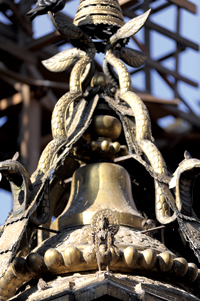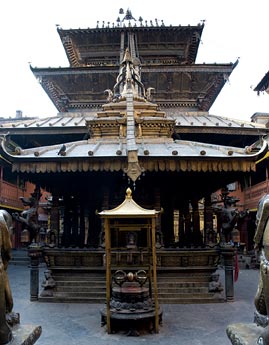January 2011
http://ecs.com.np/living_category.php?category=4&id=404


http://ecs.com.np/living_category.php?category=4&id=404
M any writers
will agree when I say that there are some things that words alone
cannot do justice to. Not only that, there are some things that even
words together with photographs cannot do justice to. These are those
that have to be personally experienced in order to truly justify the
beauty of some things, the fascination of some moments, the enthrallment
of some events. Hiranyavarna Mahavihar in Kwabahal of Patan is one such
experience. The beauty of its structure, the fascination of its
environment and the enthrallment of just being there for the moment,
these are things that words and photographs, even in concert, can never
be fully adequate as an effort towards justifiable description…

It is an early winter morning and the many lanes
of Patan are yet to come alive but once you go through the ancient door
guarded by two mammoth stone lions on either side, and enter the
hallowed precincts of Hiranyavarna Mahavihar (The Golden Temple), you
realize that you have come to a place that is already bustling with
vigorous life. In fact, the Nitya Puja (the main deity worship) takes
place at 3:00 in the morning. This vihar (a monastery where Buddhist
disciples live and learn their scriptures) is the largest and most
important of all the 18 vihars in Patan and this is the vihar where
religious rites as written in the holy sutras (religious texts) are
followed to a T. At least that is what one of the priests there, Asta
Man Bajracharya, tells me.
I meet him in the Hiranyavarna Mahavihar Digi (community building) behind the main temple and across the large courtyard in between. It houses the Chandamaharoshanaya (?) Goddess (commonly called Sankata). Sankata is an important tantric icon - she is the one who people seek blessings from to be free from their bad grahas and dashas (preordained circumstances according to astrological configurations). The small room is awash with the yellow light of many flickering flames before her impressive image. An old lady at one corner hands out butter lamp wicks to devotees. Asta Ram sits next to two other priests. One, Sajan Bir Bajracharya, has his left hand inside a cloth pouch and is continuously reciting a sutra under his breath. Before him is a rectangular object (a religious book) covered by a silk cloth and with raw rice piled on top. Asta Ram explains, “He is doing a path (invocation of spiritual blessings). This path is a month-long one”. The chief priest, Ratna Bajracharya, also sits alongside. A path can last from a few minutes to a month and more. A Karmic Tantra path that lasts for a week costs around Rs.27000 while the regular ones including the most popular one, Prajna Paramita path, begin from around Rs.500 each.
I meet him in the Hiranyavarna Mahavihar Digi (community building) behind the main temple and across the large courtyard in between. It houses the Chandamaharoshanaya (?) Goddess (commonly called Sankata). Sankata is an important tantric icon - she is the one who people seek blessings from to be free from their bad grahas and dashas (preordained circumstances according to astrological configurations). The small room is awash with the yellow light of many flickering flames before her impressive image. An old lady at one corner hands out butter lamp wicks to devotees. Asta Ram sits next to two other priests. One, Sajan Bir Bajracharya, has his left hand inside a cloth pouch and is continuously reciting a sutra under his breath. Before him is a rectangular object (a religious book) covered by a silk cloth and with raw rice piled on top. Asta Ram explains, “He is doing a path (invocation of spiritual blessings). This path is a month-long one”. The chief priest, Ratna Bajracharya, also sits alongside. A path can last from a few minutes to a month and more. A Karmic Tantra path that lasts for a week costs around Rs.27000 while the regular ones including the most popular one, Prajna Paramita path, begin from around Rs.500 each.

The Prajna Paramita is preserved as a sanctified
volume written in golden script at the main temple of Sakyamuni Buddha
in front. The pagoda style three roofed temple has a smaller temple in
front which by itself is arresting, having a gilt pagoda roof and copper
patakas (metal banners that descends from the pinnacle). This small
temple has an icon of Swayambhu Stupa inside done in silver. Through an
open door, it faces the grand silver statue of Sakyamuni Buddha within
the main temple’s silver embossed doors opposite. Here, two priests are
busy accepting the worshippers’ offerings and placing it at the
Sakyamuni’s feet. An interesting aspect here is that every morning
without fail a certain amount of rice is kept at all four corners inside
the temple. This is to feed the mice which are said to live there. It
is an age-old practice. Behind this is the legend that the location of
the vihar was determined by the then Licchavi King Bhasker Dev Verma
(12th century AD) sighting a golden mouse chasing a cat as per his
vision the night before.
Most of the devotees this morning are elderly men and women. Most of them, on entering the temple complex, touch the magnificently embossed doors with their foreheads; then they walk up to the main temple where after due worship and after receiving the tika along with the prasad (sanctified offerings), they pay homage to Swayambhu on the opposite side. Around the courtyard, at a higher level, are other icons. These include Vajra Satva, Namo Sangeeti and goddesses Tara and Manjushree as well as Mahakal and Guheswori (these, near the main entrance). According to one devotee, “Once we come here, we don’t need to visit the other big temples.” This is because most of the big deities are represented here and available for worship.
On the floor above, on the northern side, is a gumba (prayer hall) in which rows of monks can be seen sitting and reciting prayers in front of the large Amoghapasa Lokeswor (eight handed Buddha) icon at the far end of the room. A large prayer wheel stands near the door. Along the walls are aged paubhas. Similarly, on the first floor on the side opposite, is Amitabha Sukhawati Bhawan in stands an almost six feet tall statue of Amitabha Buddha. The Hiranyavarna Mahavihar is no ordinary shrine and one can easily get lost for a couple of hours immersed in its enthralling environment.
However, when you think you have seen enough and you begin to go out, you find yourself pausing awhile at the portico like space near the stone gate to look behind one more time. You want to make sure that you haven’t missed anything (you won’t have missed the Dharma Dhatu Mandala set on a double lotus podium, of course. It’s quite conspicuous). Then, somehow or the other, you find yourself looking up and gasp! Up on the ceiling is a remarkable circular metal mandala with detailed engravings. You thank the Sakyamuni for your not having missed it and you are doubly careful as you come out on the narrow street. Therefore, you give the rock façade around the gate a closer look and find an inscription that reads, “Krishna Bir, Master Stonecutter, 1881”. I tell you, the Golden Temple is an explorer’s delight!
Most of the devotees this morning are elderly men and women. Most of them, on entering the temple complex, touch the magnificently embossed doors with their foreheads; then they walk up to the main temple where after due worship and after receiving the tika along with the prasad (sanctified offerings), they pay homage to Swayambhu on the opposite side. Around the courtyard, at a higher level, are other icons. These include Vajra Satva, Namo Sangeeti and goddesses Tara and Manjushree as well as Mahakal and Guheswori (these, near the main entrance). According to one devotee, “Once we come here, we don’t need to visit the other big temples.” This is because most of the big deities are represented here and available for worship.
On the floor above, on the northern side, is a gumba (prayer hall) in which rows of monks can be seen sitting and reciting prayers in front of the large Amoghapasa Lokeswor (eight handed Buddha) icon at the far end of the room. A large prayer wheel stands near the door. Along the walls are aged paubhas. Similarly, on the first floor on the side opposite, is Amitabha Sukhawati Bhawan in stands an almost six feet tall statue of Amitabha Buddha. The Hiranyavarna Mahavihar is no ordinary shrine and one can easily get lost for a couple of hours immersed in its enthralling environment.
However, when you think you have seen enough and you begin to go out, you find yourself pausing awhile at the portico like space near the stone gate to look behind one more time. You want to make sure that you haven’t missed anything (you won’t have missed the Dharma Dhatu Mandala set on a double lotus podium, of course. It’s quite conspicuous). Then, somehow or the other, you find yourself looking up and gasp! Up on the ceiling is a remarkable circular metal mandala with detailed engravings. You thank the Sakyamuni for your not having missed it and you are doubly careful as you come out on the narrow street. Therefore, you give the rock façade around the gate a closer look and find an inscription that reads, “Krishna Bir, Master Stonecutter, 1881”. I tell you, the Golden Temple is an explorer’s delight!
No comments:
Post a Comment